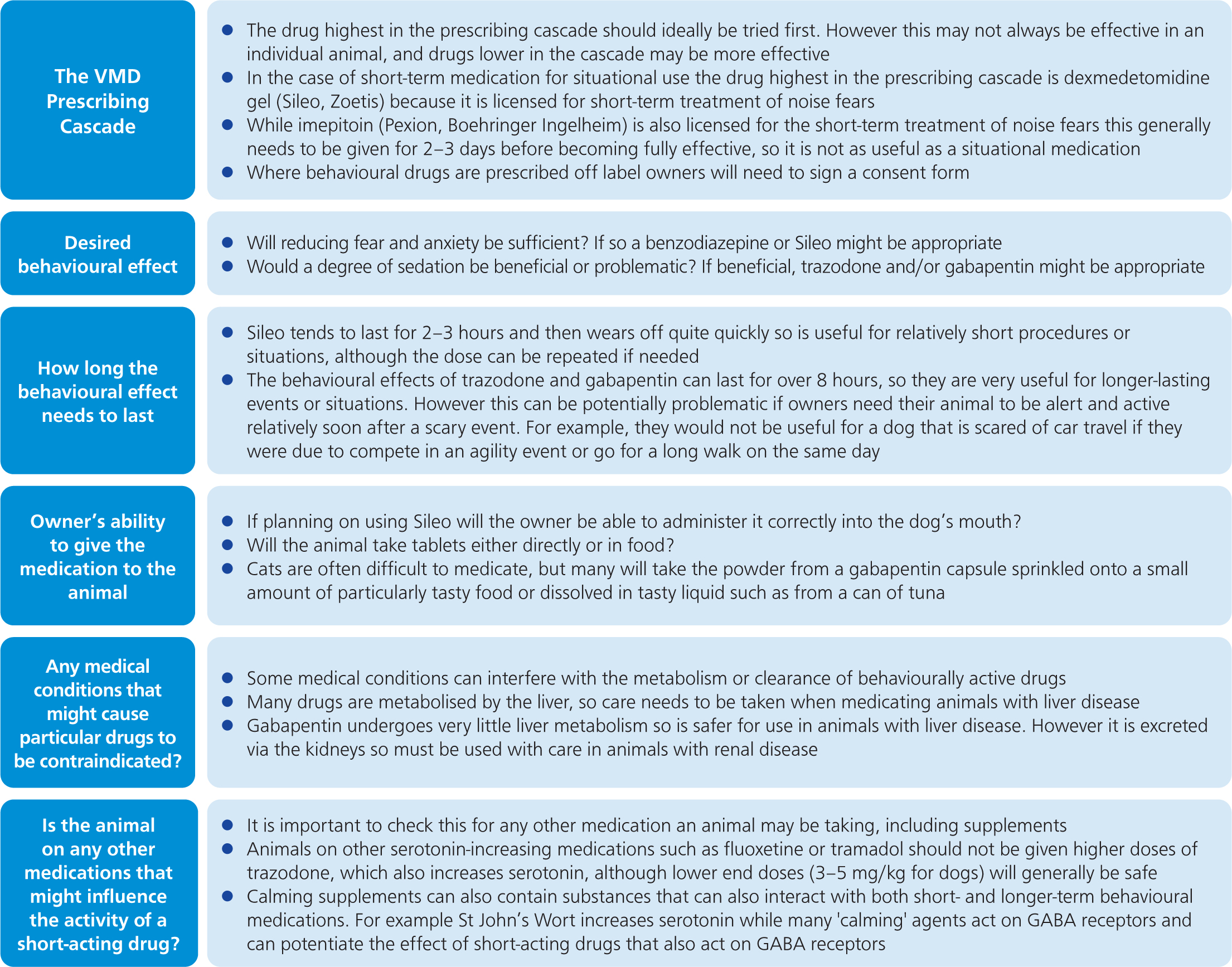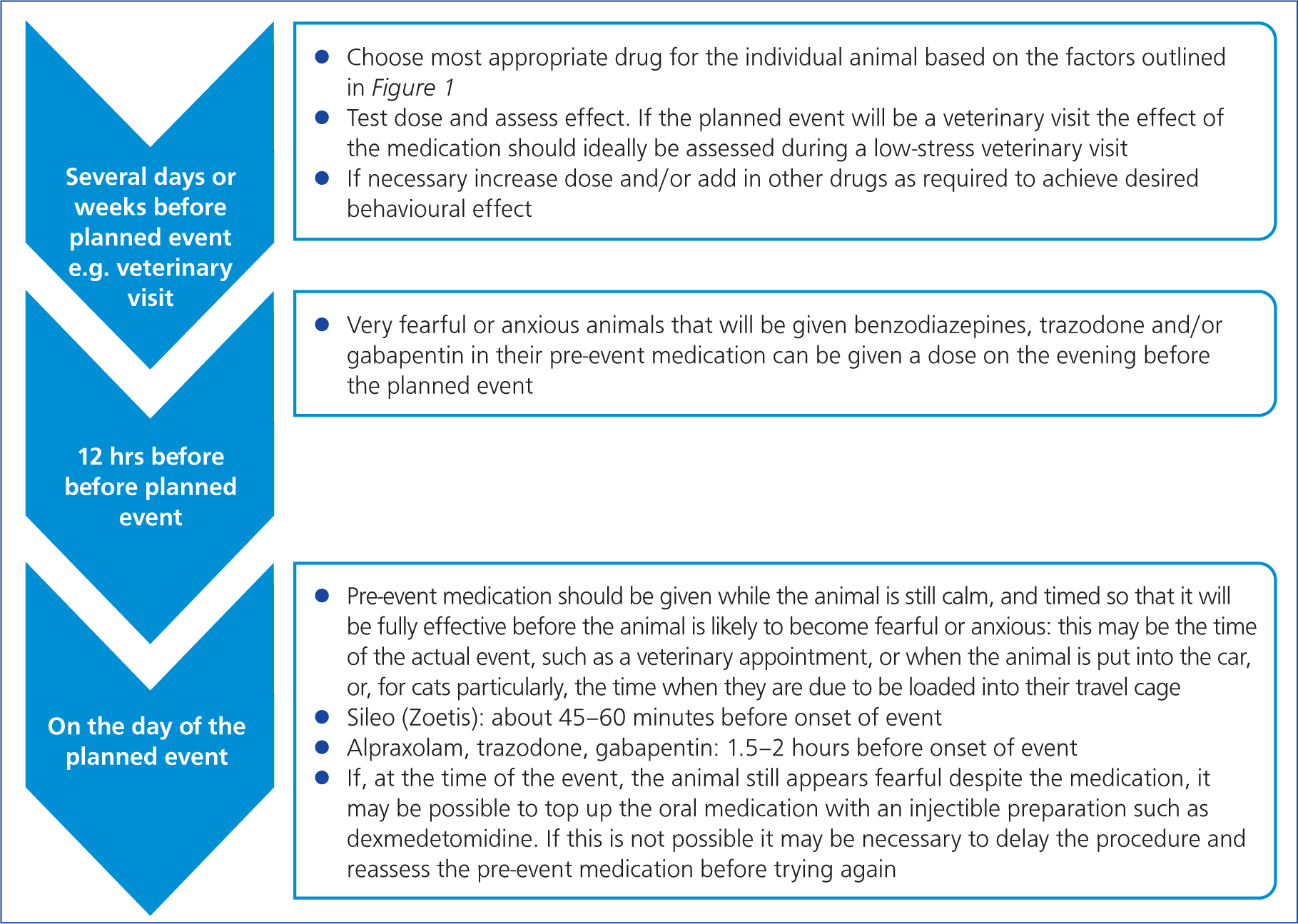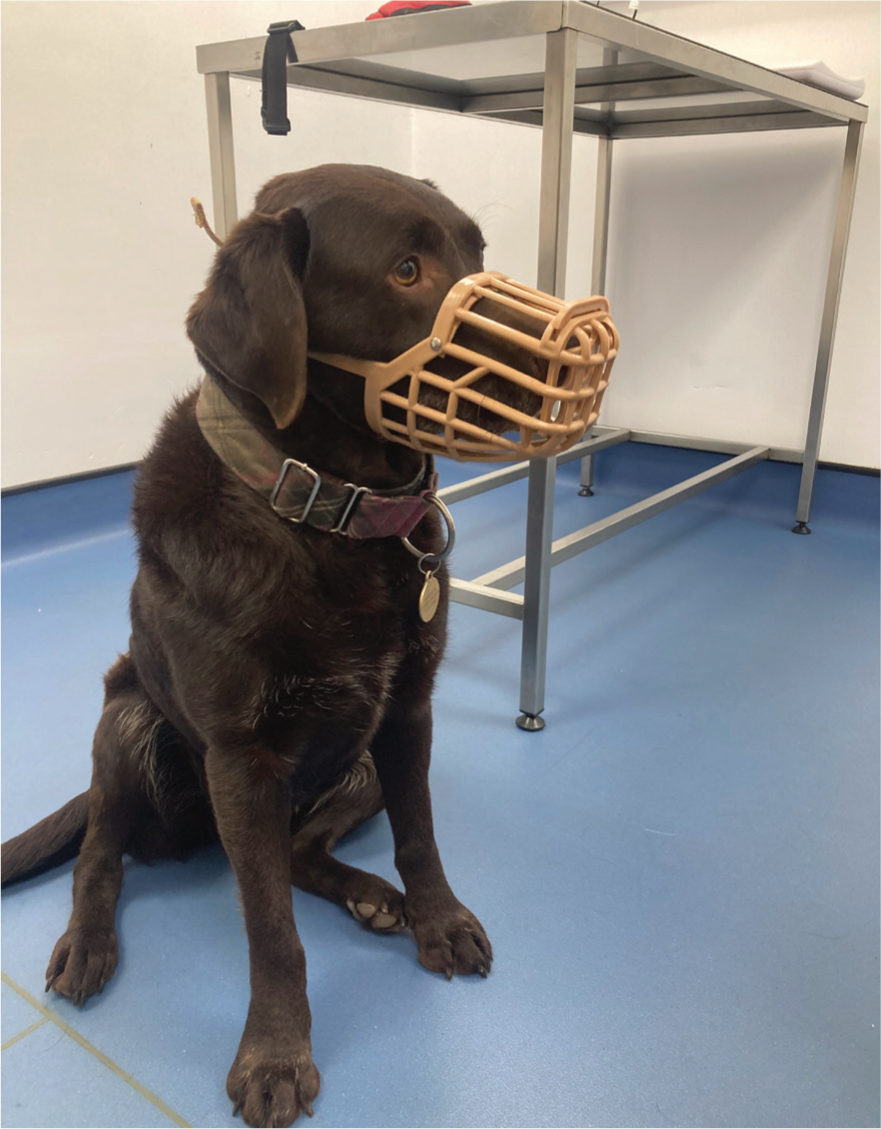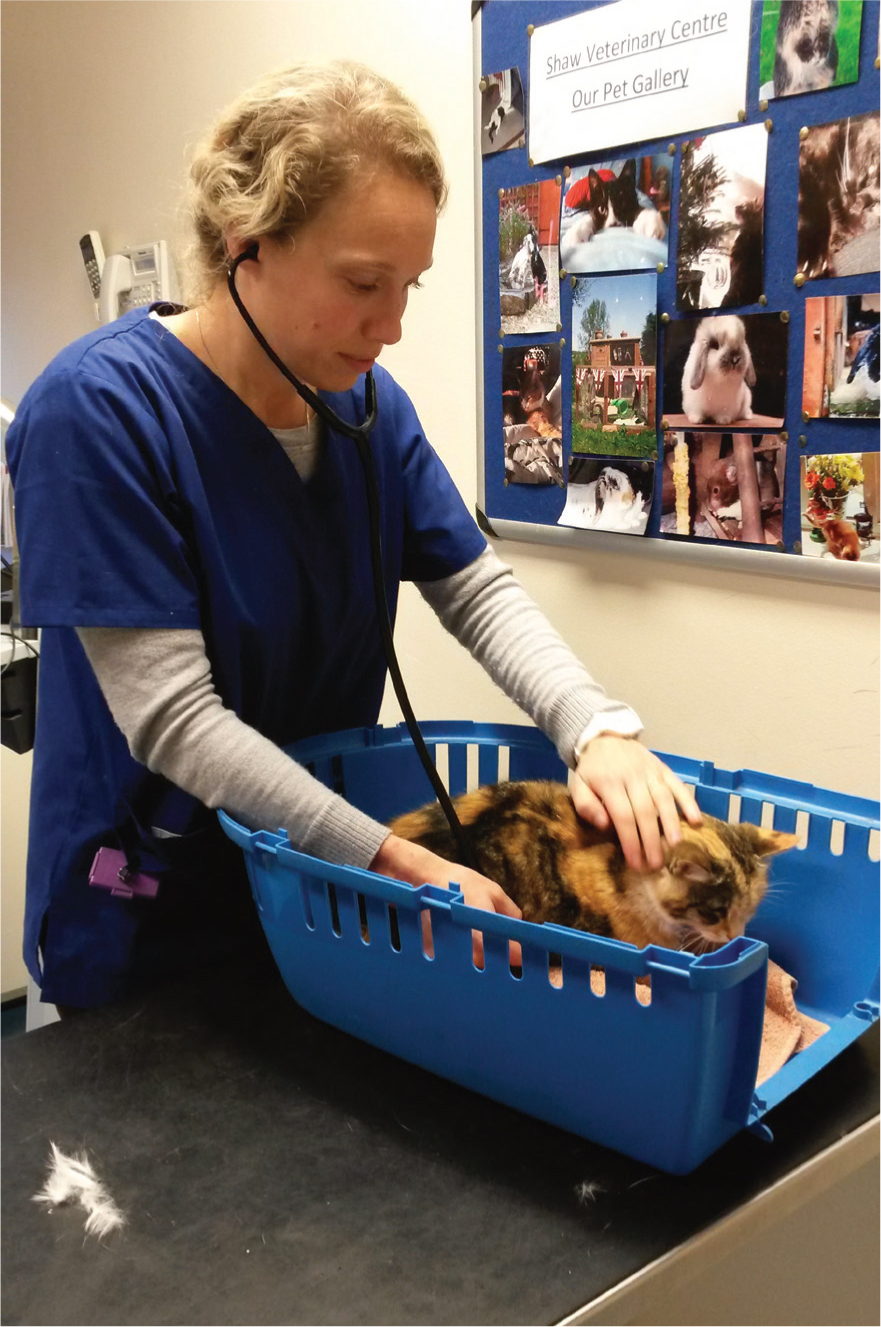Short-acting behaviourally-active drugs tend to have a calming effect, through a combination of anxiolytic and sedative effects. They can be used to help animals cope better with unavoidable scary events such as being handled in ways the animal finds unpleasant or exposed to loud, scary noises such as fireworks or thunderstorms.
Veterinary nurses are very likely to encounter animals that will benefit from short-acting medication, particularly those that are worried about being handled in the veterinary surgery. They may also be asked by owners for help with animals that are difficult to handle in other situations such as when being groomed, or those that are fear-ful when travelling or of loud noises. An understanding of the various short-acting drugs available and the ways in which they can potentially influence behaviour will enable veterinary nurses to assist veterinary surgeons in choosing the most appropriate short-acting medications for individual animals. Information about the individual drugs most commonly used for short-acting or situational medication including dose rates were outlined in Part 1. This article focuses on the decision-making process involved in choosing the most appropriate drugs for an individual animal.
General principles for choosing and using short-acting behaviourally-active medication
There are a number of different factors that need to be taken into consideration when choosing the most appropriate short-acting behavourally-active drugs for an individual animal. These are outlined in Figure 1.

It is important to be aware that animals can vary quite significantly in the way they respond to the different shortacting drugs available, and also in the doses that will be effective. Drugs should ideally be test-dosed before a planned appointment or event, both to determine the most effective drug or combination of drugs, and also the most effective dose(s) for that animal. This will also identify any potentially problematic side effects, such as marked sedation, ataxia or behavioural disinhibition, before the drug is used for a particular event:
- If there is sufficient time before the predicted event it is generally best to start with low to medium doses of individual agents, and if necessary, increase the doses and/or add in other drugs until the required effect is achieved
- In many cases higher-end doses of individual drugs are associated with an increased likelihood of problematic side effects such as ataxia without any significant increase in anxiolytic effect. If medium doses of an individual agent are not sufficiently effective, it is generally better to either add in a second drug or try a different drug altogether.
- Combinations of two or even three different short-acting drugs given at lower doses will often be more effective, and less likely to cause problematic side effects, than higher doses of individual drugs. However, when using combinations of different medications, it is important to be aware of the potential for adverse interactions, to start with lower end doses of the individual agents and to increase doses very gradually only if needed.
- All drugs have the potential to cause problematic side effects and sometimes these will be severe enough to preclude using a particular drug in an individual animal. For example, benzodiazepines and other drugs that act on benzodiazepine receptors such as imepitoin (Pexion, Boehringer Ingelheim) have the potential to cause behavioural disinhibition, and this can, rarely, include disinhibition of aggressive behaviour. While relatively uncommon it is important that owners are aware of this possibility, and that, if it occurs they will need to take care not to expose their animals to situations that might trigger them to show aggressive behaviours until the effect of the drug wears off. If it is not possible to avoid these situations it would be safer to use drugs that are less likely to disinhibit behaviour. While it is not uncommon for some of these drugs to cause a mild degree of ataxia, some animals may experience more significant ataxia, with a subsequent risk of injuring themselves, even at low-to moderate doses.
Drugs will always be more effective if they are given before an animal starts to become agitated or stressed. See Figure 2 for a suggested time-line for giving drugs before a planned event.

Where an event is unplanned and unavoidable, such as an emergency veterinary visit, it may not be possible to test dose medication beforehand. In which case the choice of medication will need to be based on the judgement of the clinical team, taking into consideration a number of factors including the behavioural effect required in order to ensure the safety of the people handling the animal as well as the animal's welfare. This may require using combinations of agents at moderate doses without the chance to test-dose them first.
Note, oral acepromazine (ACP) was traditionally used as a calming or ‘restraining’ agent in the past. However, it does not reliably reduce fear or anxiety or cause sedation when used alone, and it can potentially increase sensitivity and reactivity to noises. It should never be used alone as a short-acting behavioural medication, and its only useful role is as an adjunct to other more effective anxiolytic and sedative agents, in animals that are extremely difficult and potentially dangerous to handle.
All the short-acting medications listed in Part 1 of this article, Table 1 (Warnes, 2022), either individually or in combination, are compatible with further sedation, for example with dexmedetomidine, or general anaesthesia, if an animal requires this. However it is important to be aware that lower doses of sedatives or anaesthetic agents may be needed
Examples of the use of short-acting medication in specific situations
Case 1: A dog that is difficult to handle in the veterinary surgery needs a booster vaccination
Signalment: Tod is a 4-year-old neutered male Collie x Lab-rador
- Tod was very nervous and wriggly when examined and injected as a puppy
- Over the years he has become increasingly agitated in the consulting room, and has needed increasing levels of restraint including muzzling, in order to examine and inject him
- His booster is due, and he needs to have this before he goes to stay with a dog sitter in a couple of weeks' time.
Aims: to be able to give Tod a general health check and booster vaccination without further increasing his dislike of being handled in the veterinary practice, and without any risk of Tod biting anyone
Treatment plan
Short-term plan
- Medication: use short-acting medication to reduce Tod's fearfulness and help him remain calm during the examination and booster vaccination. As this will be a planned procedure there is time to experiment with short-term medications to see which drug(s) and dose(s) are likely to be most effective for him. Ideally the medication will reduce the degree of fearfulness and anxiety he experiences, and also cause a degree of sedation to counter the increased levels of arousal and activity he tends to show in the veterinary surgery.
- Sileo is potentially a good option to try initially as, in addition to being highest in the prescribing cascade, it can reduce arousal as well as anxiety. A recent study has shown that oral dexmedetomidine gel can successfully reduce fear and anxiety associated with veterinary handling (Korpivaara et al, 2021). However, if this is not sufficiently effective for Tod, or if the owner is unable to administer it for any reason, it will be necessary to try an alternative medication.
- Trazodone would be a good alternative to try, because of the fact that it will generally cause a degree of sedation as well as anxiolysis, and as Tod is not on any other serotonin-increasing medication he could start on a moderate dose of between 5 and 10 mg/kg. The owner should be asked to give this a couple of hours before they bring Tod into the surgery for his assessment appointment.
- If trazodone alone is not sufficiently sedating, a dose of gabapentin, at between 10–20 mg/kg could be added, as this tends to be more sedative.
- If Tod still appears fearful or anxious after having trazodone and gabapentin it would be worth adding in alprazolam for its anxiolytic effect.
- Once the desired effect is achieved, the owner should be asked to give Tod a dose of the medication the evening before and another dose 2 hours before the planned vaccination visit, to ensure it is as effective as possible.
- Ensure the veterinary visit is as minimally stressful as possible for Tod:
- Encourage the owner to wait with Tod in the car/in an empty consultation room until the appointment time, rather than in the waiting room, as the movement of people and other animals in and out may be too stimulating for him.
- Depending on the degree of sedation he is experiencing, the owner may need some assistance getting him into the practice. It may be easier to examine him and inject him in the car.
- Use gentle, low stress handling at all times during the consultation (Riemer et al, 2021). See Resources for more information.
Longer-term plan
- Muzzle training: Tod should be taught to be comfortable wearing a muzzle if he is not already (Figure 3). See Resources section for more information.
- Teach Tod to be more comfortable with being approached and then handled in the veterinary surgery using systematic desensitisation and counter-conditioning (Riemer et al, 2021). See Resources for more information.

Case 2: A cat known to be fearful when travelling in the car and difficult to handle in the veterinary surgery needs a booster vaccination before a stay in cattery
Signalment: Lily is a 6-year-old neutered female Domestic Short Hair (DSH) cat:
- Lily has always been timid and tends to hide in the back of her travel cage when she is brought to the veterinary surgery.
- She will sometimes hiss and swipe if you or her owner reaches in to try and get her out
- She usually needs to be restrained quite firmly in order to examine and inject her.
- The owners also report that Lily becomes highly distressed when travelling in the car. She vocalises and occasionally urinates or defecates in her travel cage.
Aims: to ensure that Lily can be examined and have her booster injection without further increasing her fearfulness. To reduce stress associated with car travel, both to the veterinary surgery and to and from the cattery.
Treatment plan
Short-term plan
- Lend, or encourage the owners to buy, a travel cage that comes apart in the middle so the top half can be lifted off. This will mean that Lily can be examined and injected without having to forcibly remove her from the cage (Figure 4).
- Short-acting medication to reduce Lily's fearfulness during car travel and while she is in the veterinary surgery.
- Studies suggest that both trazodone and gabapentin can reduce fearfulness associated with car travel and veterinary visits in cats (Stevens et al, 2016; van Haaften et al, 2017).
- Gabapentin is generally well tolerated and is worth trying first.
- Most cats respond well to a dose of 100 mg, although very small, elderly or infirm cats should be given a lower dose of 50 mg.
- The capsule can be opened and the powder sprinkled on a small amount of tasty food or dissolved in a small amount of tasty liquid, such as the liquid from a tin of tuna.
- Trazodone can be tried instead, if gabapentin is not sufficiently effective, or if Lily does not tolerate it well for any reason.
- Most cats respond well to a dose of 50 mg, although a lower dose of 25 mg may be better for particularly small, elderly or infirm cats.
- In either case, the dose of medication should be given 2 hours before Lily needs to be put into the basket before travelling to the veterinary surgery or cattery.
- The effects of the medication will last for at least 8 hours, long after Lily returns home from the veterinary appointment. In addition to sleepiness these effects can include ataxia, making jumping and climbing difficult and potentially dangerous. Lily's owners need to be aware that she should be kept indoors and monitored carefully until the effects of the medication have worn off fully.
- Ensure the veterinary visit is as minimally stressful as possible for Lily
- Encourage the owners to wait with Lily in the car until the time of their appointment.
- Use gentle, low-stress handling at all times during the consultation (Riemer et al, 2021). See Resources for more information.

Longer-term plan
- Teach Lily to be more comfortable with being in her travel cage (see Resources)
- Teach Lily to be more comfortable with being handled in the veterinary surgery (see Resources).
Case 3: A dog that is scared of bangs will be exposed to a neighbourhood firework display at the weekend
Signalment: Milo is a 5-year-old neutered male Labrador
- Milo has always been a bit worried about loud noises but his owner reports that over the last year or so he has become particularly fearful of bangs such as fireworks.
- Whenever he hears loud bangs he becomes very agitated and pants, drools and paces around the house, and afterwards he refuses to go outside the house, even to toilet, until the next morning.
- Milo's owner has come into the surgery and asks to speak to you on reception because she is worried about how he will react to a large public firework display that is due to happen just down the road in a few days' time. She would like to know if you can give Milo anything to calm him down when this happens.
Treatment plan
Short-term plan
- Veterinary check: there is a significant relationship between pain and the onset or exacerbation of noise fears in dogs (Mills et al, 2020).
- It is important that Milo has a thorough examination as soon as possible, to see if there is any source of pain, such as joint pain or digestive issues for example, that might be exacerbating his fear of bangs. If there is, this will need to be treated in addition to addressing his fear of noises.
- Be aware that any analgesic medication given may influence the choice of behavioural drugs that can be used, particularly with regard to longer-acting behavioural drugs.
- Short-acting medication to reduce Milo's fear of loud bangs and associated anxiety (refusal to leave house after dark after bangs have been heard). The degree of distress Milo is showing when he hears bangs means that he will benefit from short-acting behaviourally-active drugs. Calming supplements are very unlikely to be sufficiently effective for him. Because the firework display is a few days away there is time to test-dose medication.
- There are two drugs licensed for the short-term treatment of noise fears, dexmedetomidine oro-mucosal gel (Sileo, Zoetis) and imepitoin (Pexion, Boehringer Ingelheim).
- Because Milo tends to become agitated when he is frightened it is probably best to try Sileo first, as this also tends to lower arousal, assuming the owner is able to handle Milo to administer it correctly. The dose is 125 µg/m2 and there is a dosing guide on the packaging.
- If the owner is unable to give Sileo, or if it is not sufficiently effective, Pexion can be tried: this is dosed at 30 mg/kg twice daily, and generally needs to be given for a couple of days leading up to the scary event in order to achieve its full anxiolytic effect.
- Very occasionally Pexion can cause increased arousal and activity levels in dogs. If this happens with Milo, or if neither Sileo or Pexion are sufficiently effective for him, other options such as Trazodone with or without added gabapentin or alprazolam could be tried.
On the night of the local firework display the chosen medication should be given before Milo starts to become worried or anxious, and at a sufficient time before the fire-works are due to start, so that the medication is fully effective before the first bangs are heard. This medication can also be used on other nights when fireworks are likely to be heard over the firework period.
- First aid behavioural advice: in addition to the short-term medication the owner will benefit from some first-aid advice on how to minimise Milo's exposure to firework sounds as much as possible, including how to create a den or safe place and encourage him to settle here. See Resources section for links to more detailed first aid behavioural advice for helping fearful dogs cope with fireworks.
Longer-term plan
- Continue to monitor Milo's health, particularly if a source of discomfort has been identified. Ensuring any pain is managed as effectively as possible will be important for his welfare generally and may potentially reduce his sensitivity to loud noises.
- Unless there is sufficient behavioural expertise within the practice, consider referring Milo to an appropriately qualified behaviourist, such as those listed on the Animal Behaviour and Training Council (ABTC) Clinical Animal Behaviourist or Veterinary Behaviourist registers. The behaviourist will be able to assess the extent of Milo's sensitivity to noises: if Milo is also worried about other sounds that might be more frequently encountered such as gunshots or bird scarers he may benefit from longer-term behavioural medication in addition to the short-acting situational medication. In the longer term the behaviourist will also be able to teach Milo to be less worried about particular sounds, using a combination of desensitisation and counter-conditioning.
Conclusion
Short-acting behaviourally-active drugs tend to have a calming effect. Used alongside other behavioural strategies they can help nervous animals cope better with unavoidable scary situations such as car travel, being handled at the veterinary practice or groomers and exposure to scary loud noises. Used effectively, they can reduce the chances of fear-related problems getting worse, and in the case of animals that may be difficult to handle they can also increase the safety of the people handling them. Having a good understanding of the various short-acting drugs available will enable veterinary nurses to effectively assist veterinary surgeons in choosing the most appropriate medication(s) for individual animals, to know what to expect when handling animals that have been given them and to effectively advise owners about their potential effects on their animals' behaviour.
KEY POINTS
- Veterinary nurses are very likely to encounter animals that will benefit from short-acting medication, either to facilitate handling in the veterinary surgery or to help them cope better with other unavoidable scary situations such as grooming or exposure to loud noises.
- Individual animals can vary quite significantly in the way they respond to the different short-acting drugs available, and also in the doses that will be effective.
- Ideally short-acting behaviourally-active drugs should be test-dosed before planned procedures or events, both to determine the most effective drug or combination of drugs, and also the most effective dose(s) for that animal.
- In many cases higher-end doses of individual drugs are associated with an increased likelihood of problematic side effects such as ataxia without any significant increase in anxiolytic effect. If medium doses of an individual agent are not sufficiently effective, it is generally better to either add in a second drug or try a different drug altogether.
- Where events are unplanned and unavoidable test-dosing may not be possible. In these cases the choice of medication will need to be based on consideration of a number of factors including the behavioural effect required in order to ensure the safety of the people handling the animal as well as the animal's welfare. This may require using combinations of agents at moderate doses without the chance to test-dose them first.
Resources
Fellowship of Animal Behaviour Clinicians (FABC) website: www.fabclinicians.org Vet CPD Webinar and Q&A sessions: https://fabclinicians.org/veterinary-q-and-a-sessions/
- Situational medication: S Penturn and L Notari
- Emergency management of sound sensitivities: E Baker and E Brown
- Long-term management of sound sensitivities: E Baker and E Brown.
Available from the FABC Links for Veterinary Professionals page: https://fabclinicians.org/links-for-veterinary-professionals/
Articles:
- Overview of Behaviour Supplements for Dogs and Cats by Lorella Notari
- Behavioural First Aid advice for dogs
- Behavioural First Aid advice for cats
FABC YouTube Veterinary Playlist: Preparing your pet for the vet. https://fabclinicians.org/links-for-veterinary-professionals/
Many useful videos including:
- Muzzle Training for dogs: Linda Ryan
- Preparing your cat for the vet: Linda Ryan
- Vet training for cats: S Ellis.
International Cat Care website: www.icatcare.org
Resources for helping cats to feel comfortable in a cat carrier:
- https://icatcare.org/advice/putting-your-cat-in-a-cat-carrier-video/
- https://icatcare.org/advice/encouraging-your-cat-to-be-happy-in-a-cat-carrier-video/


